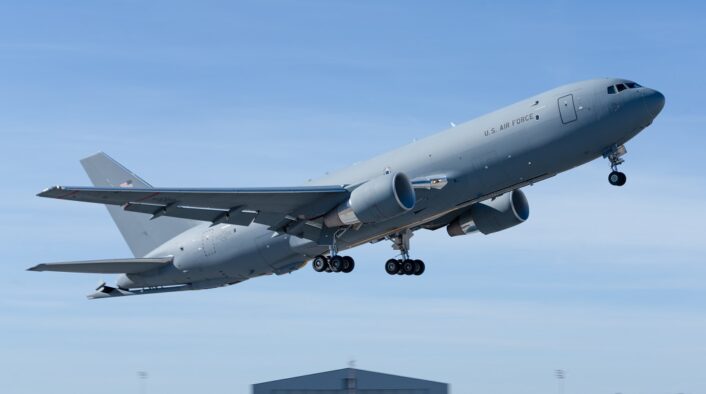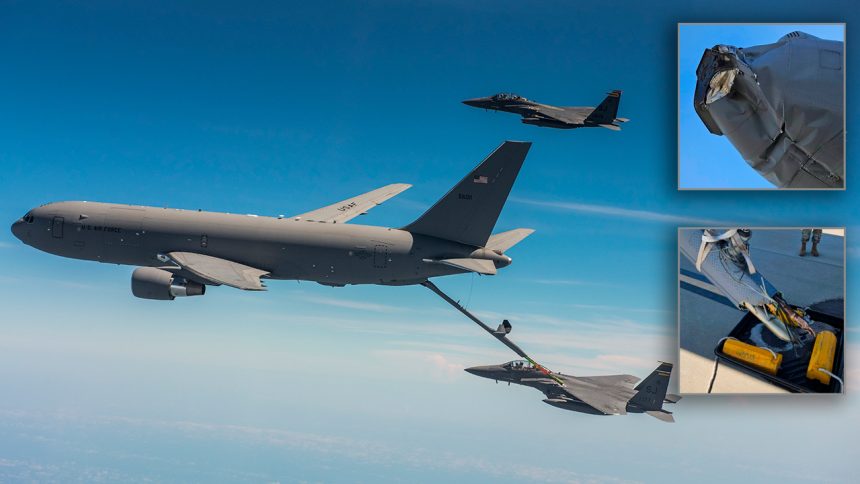The KC-46 was refueling F-15Es which were enforcing a Presidential Temporary Flight Restriction, with both aircraft involved in the mishap performing emergency landings.
A KC-46A Pegasus tanker has been involved in yet another refueling mishap, this time off the coast of California. The aircraft, callsign WIDE12, was refueling two F-15Es, callsigns NOBLE41 and NOBLE42, as they were enforcing a presidential Temporary Flight Restriction (TFR) on Aug. 21, 2024.
The KC-46s belongs to the 931st Air Refueling Wing at McConnell Air Force Base, Kansas, the same unit of the tanker involved in the incident between a KC-46 and an F-16 off the coast of the Netherlands on Jul. 2. The F-15Es, which at the time of the incident were also reportedly carrying live weapons, are assigned to Mountain Home AFB, Idaho, and specifically to the 391st Fighter Squadron, according to local news outlets.
As NOBLE42 was refueling, an unknown problem caused damage to both the Strike Eagle and the tanker. NOBLE41’s crew communicated via radio to the air traffic control that NOBLE42 suffered hydraulic problems, while the KC-46 possibly had problems to the boom, with WIDE12 also acknowledging hydraulic problems.
Photos published on the unofficial Air Force amn/nco/snco Facebook page shows the KC-46’s tail cone damaged and part of the boom, still in the lowered position, missing, while the remaining part was further damaged after scraping on the runway. The 931st ARW, however, could not confirm the authenticity of the photos, mentioned Air and Space Forces Magazine.
The KC-46 was operating out of Travis AFB, California, where it returned to perform an emergency landing. The base later stated that the tanker had to land with its boom down and dropped a “portion” of it nearby.
The F-15E, according to the radio communications, suffered hydraulic problems and diverted to Fresno, California, for an emergency landing. However, according to local news, the arresting cable broke during the first landing attempt. The pilot reportedly went around for another attempt on the opposite side of the runway, but this time the hook did not engage the cable, with the aircraft further diverting to NAS Lemoore where it safely landed.
Wild ATC audio, a lost tail boom and live missiles turns into quite the story 👀
NOBLE42 (F-15E Mountain Home AFB) had a incident with WIDE12 (Boeing KC-46 17-46028) yesterday near Santa Barbara, California while refueling during a CAP (Combat Air Patrol) which was enforcing a… pic.twitter.com/VkIJJZ1OIT
— Thenewarea51 (@thenewarea51) August 23, 2024
The incident is now under investigation to find out the causes. As mentioned earlier, this is the second refueling mishap for the KC-46 in under two months and adds to the long list of the Pegasus’ problems.
The troubled KC-46
While the KC-46A Pegasus is gradually taking over more missions to lessen the load on KC-135’s units, it still has many issues. As of Jan. 2024, the KC-46 has six category 1 deficiencies, which could cause loss of an aircraft, injury, or death, according to the Air Force classification. Work is ongoing to fix them once for all.
The first, possibly the most important, is related to the cameras which replaced the boom operator’s window. There are two groups of cameras: the Remote Vision System (RVS), which focuses on the boom, and a second group which provides a panoramic view to the rear of the tanker. Both systems struggle under certain environmental conditions and Boeing is working on an RVS 2.0, expected in late 2025.
Another problem is related to the boom, and specifically an actuator inside the boom which prevents the A-10C to be refueled. In fact, the A-10 can’t generate enough force to stay connected to the boom due to its low speed, so the hydraulic actuator provides that force to keep the boom rod in the receptacle. A new actuator is expected by 2026.
Then, there are product quality issues, which involve three separate parts of the aircraft: drain masts for its auxiliary power unit (APU), a seal for its fuel manifold and a drain line that runs near the cockpit. Specifically, the APU’s drain masts showed a tendency to crack, solved with additional reinforcements.

The fuel manifold, which runs 555 feet throughout the plane, is fitted with flex couplings throughout so that it can bend in flight. Incorrect positioning of the coupling’s seals enabled fuel to seep out of the inner tube into the outer one, so Boeing implemented a new flex seal.
The last one was related to the AAR receptacle on top of the cockpit, specifically the receptacle drain line, which empties liquid out but is at risk of cracking and could cause fuel to leak into the cockpit. A fix has been found and should be implemented by next year.
Adding to this, there is another problem with a key feature, the Wing Aerial Refueling Pods. The WARPs, mounted on the aircraft’s wings, are designed to refuel two aircraft simultaneously, however the Director of Operational Test & Evaluation’s 2023 annual report mentioned the pods did not yet enter Initial Operational Test & Evaluation (IOT&E) because they didn’t achieve the FAA supplemental-type certification.
Specifically, the WARPs did not meet certification requirements for cowling bird strike, lightning tolerance, and wiring corrosion protection. The Air Force stated that certification is ongoing and IOT&E should start this year.









